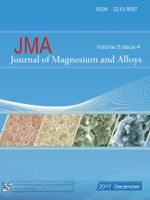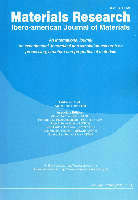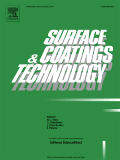
Journal of Magnesium and Alloys
Scope & Guideline
Advancing the Future of Materials Science
Introduction
Aims and Scopes
- Material Properties and Characterization:
Research in this area focuses on the mechanical, thermal, and corrosion properties of magnesium alloys, examining how different compositions and processing techniques affect their performance. - Manufacturing and Processing Techniques:
This includes studies on various methods such as casting, extrusion, additive manufacturing, and surface engineering, emphasizing advancements that improve the fabrication and performance of magnesium components. - Biomedical Applications:
The journal explores the use of magnesium alloys in medical applications, particularly biodegradable implants, assessing their biocompatibility, degradation rates, and mechanical properties. - Corrosion Behavior and Protection Strategies:
Papers in this scope investigate the corrosion mechanisms of magnesium alloys and propose innovative coatings and treatments to enhance their durability in various environments. - Hydrogen Storage and Energy Applications:
Research on the use of magnesium-based materials in hydrogen storage technologies and as anodes in batteries, focusing on improving efficiency and sustainability. - Advanced Coatings and Surface Modifications:
Studies that develop and analyze various coatings for magnesium alloys to enhance corrosion resistance, biocompatibility, and mechanical performance.
Trending and Emerging
- Biodegradable Magnesium Alloys:
Research on biodegradable magnesium alloys for medical implants is rapidly gaining traction, emphasizing their potential for bone regeneration and reduced environmental impact. - Additive Manufacturing and 3D Printing:
The application of additive manufacturing technologies to produce complex magnesium alloy structures is an emerging trend, highlighting innovative fabrication techniques and new design possibilities. - Machine Learning and Data-Driven Approaches:
The integration of machine learning and data analytics in the design and optimization of magnesium alloys is becoming increasingly popular, facilitating accelerated discovery and property prediction. - Corrosion Inhibition Techniques:
There is a growing interest in advanced corrosion protection methods, including novel coatings and surface treatments that enhance the durability of magnesium alloys in harsh environments. - Sustainable and Eco-Friendly Solutions:
Research focused on sustainability, including the recycling of magnesium alloys and the development of eco-friendly processing methods, is becoming a significant trend, aligning with global environmental goals. - Multifunctional Coatings for Biomedical Applications:
The development of multifunctional coatings that provide both corrosion resistance and bioactive properties for magnesium implants is an emerging theme, driving innovation in the biomedical field.
Declining or Waning
- Basic Research on Magnesium Chemistry:
There has been a noticeable decrease in fundamental studies focused solely on the chemistry of magnesium. As the field matures, researchers are increasingly applying chemical principles to practical applications rather than exploring basic chemistry. - Traditional Casting Methods:
Research focused on conventional casting methods is becoming less prominent, as advanced manufacturing techniques such as additive manufacturing and rapid solidification processes gain popularity. - Theoretical Studies without Experimental Validation:
The journal has seen fewer submissions of purely theoretical studies that lack experimental validation. There is a growing emphasis on research that combines theoretical insights with practical applications. - Niche Applications in Non-Biomedical Fields:
Research exploring niche applications of magnesium alloys outside of biomedical and aerospace fields is declining, as the focus shifts towards more impactful and widely applicable uses. - Low-Temperature Processing Techniques:
Interest in low-temperature processing techniques for magnesium alloys appears to be waning, with a preference shifting towards high-temperature methods that yield better mechanical properties.
Similar Journals

International Journal of Applied Ceramic Technology
Connecting researchers to the latest in ceramic advancements.International Journal of Applied Ceramic Technology, published by WILEY, serves as a key platform for advancing the field of ceramics and composites with a rich focus on innovation and practical applications. With an ISSN of 1546-542X and E-ISSN 1744-7402, this journal has established its presence in multiple disciplines, indicated by its impressive Q3 rankings in Ceramics and Composites, Condensed Matter Physics, Marketing, and Materials Chemistry as of 2023. Covering research from 2004 to 2024, it provides a comprehensive repository of knowledge that aids in the understanding and development of materials. Although it lacks Open Access options, the journal maintains rigorous peer-review standards that ensure high-quality publications for researchers, professionals, and students alike. Given its scopus rankings, including a commendable #61 in Ceramics and Composites, this journal is pivotal for anyone looking to deepen their expertise and engage with the latest advancements in ceramic technology.

Surfaces is an esteemed academic journal published by MDPI in Switzerland, operating as an open access platform since 2018. With an E-ISSN of 2571-9637, this journal focuses on the interdisciplinary advancements in the fields of chemistry, materials science, and physics, particularly in the domain of surfaces and interfaces. As a testament to its scholarly impact, Surfaces is ranked in the second quartile for multiple categories as of 2023, including Chemistry (miscellaneous), Materials Science (miscellaneous), Surfaces and Interfaces, as well as Surfaces, Coatings and Films, showcasing its relevance within these disciplines. Researchers and professionals seeking to disseminate and acquire knowledge on the latest innovations can benefit from the journal's rigorous peer-review process and commitment to quality, ensuring visibility and accessibility for current developments in surface technology and material interactions. With a growing archive from 2019 to 2024, Surfaces stands out as a vital resource for the academic community.

Materials Research-Ibero-american Journal of Materials
Exploring new horizons in condensed matter and materials engineering.Materials Research-Ibero-american Journal of Materials, published by the UNIV FED SAO CARLOS, DEPT ENGENHARIA MATERIALS, is a prominent platform dedicated to advancing the field of materials science. Launched in 1998, this Open Access journal has fostered a culture of inclusive knowledge sharing, allowing researchers and practitioners worldwide to access valuable insights in Condensed Matter Physics, Materials Science, Mechanical Engineering, and Mechanics of Materials. With a commendable Q3 ranking in these diverse categories in 2023, the journal provides a vital resource that bridges theoretical research and practical applications in materials technology. Covering a range of topics from novel material characterization to innovative engineering solutions, Materials Research serves as a critical forum for contributors across the globe, particularly those in Latin America. Researchers, students, and professionals are encouraged to engage with this journal, which operates with a clear commitment to high standards and is based in São Carlos, Brazil, further enhancing its relevance and appeal within the international materials research community.

JOURNAL OF MATERIALS ENGINEERING AND PERFORMANCE
Advancing the Frontiers of Materials ScienceJOURNAL OF MATERIALS ENGINEERING AND PERFORMANCE, published by Springer, serves as a vital resource for researchers and professionals in the fields of materials science, mechanical engineering, and mechanics of materials. With an ISSN of 1059-9495 and E-ISSN of 1544-1024, this journal boasts a commendable track record since its inception in 1992 and is set to continue providing valuable insights until 2024. Positioned in the Q2 quartile of its categories, the journal is ranked #246 in Mechanical Engineering and #168 in Mechanics of Materials according to Scopus, reflecting its commitment to high-quality research. While currently not adopting an open access model, it remains accessible to academic professionals and students eager to advance their knowledge in the rapidly evolving domain of materials engineering. The scope encompasses innovative research focused on material performance, engineering applications, and technological advancements, making it an indispensable tool for those at the forefront of the field.

INTERNATIONAL MATERIALS REVIEWS
Transforming Research into Practical ApplicationsINTERNATIONAL MATERIALS REVIEWS, published by SAGE Publications Inc, is a leading journal dedicated to the comprehensive analysis of contemporary research in the fields of materials chemistry, mechanical engineering, mechanics of materials, and the study of metals and alloys. With an impressive impact factor and a Q1 ranking across multiple categories such as Materials Chemistry and Mechanical Engineering in 2023, it ranks amongst the top journals for innovative materials research. The journal has a long-standing history since its inception in 1987 and continues to serve as a crucial resource for academics and professionals alike. Although it is not open access, it is renowned for its rigorous peer-review process and its commitment to disseminating high-quality materials science research globally. Researchers, students, and industry professionals benefit greatly from the journal's insightful reviews, both for the advancement of theoretical knowledge and practical applications within the fast-evolving materials field.

SURFACE & COATINGS TECHNOLOGY
Innovating Coatings for a Sustainable FutureSURFACE & COATINGS TECHNOLOGY is a premier academic journal that has been at the forefront of research and innovation since its inception in 1986, diligently published by Elsevier Science SA. With an impressive range of studies focusing on surface and coatings technologies, the journal has established itself as a leading platform within the fields of Chemistry, Condensed Matter Physics, and Materials Science. Notably, it holds a distinguished Q1 ranking in multiple categories, showcasing its relevance and high impact in the academic community. Furthermore, it is recognized for its rigorous peer-review process and is indexed in esteemed databases, maintaining its strong position with a ranking of #17 in Surfaces, Coatings, and Films. Although the journal does not currently offer open access options, it continues to be a crucial resource for researchers, professionals, and students seeking insights into cutting-edge developments and applications in the domain of surface engineering. With a commitment to advancing knowledge across these disciplines, SURFACE & COATINGS TECHNOLOGY is an essential read for anyone interested in the latest trends and technologies shaping the industry.

SURFACE ENGINEERING AND APPLIED ELECTROCHEMISTRY
Fostering Global Dialogue in Surface EngineeringSURFACE ENGINEERING AND APPLIED ELECTROCHEMISTRY, published by PLEIADES PUBLISHING INC, stands as a pivotal resource in the realms of engineering and materials science. With an ISSN of 1068-3755 and an E-ISSN of 1934-8002, this journal encompasses an extensive scope that includes industrial applications, and innovative surface treatments, fostering advancements in the fields of Industrial and Manufacturing Engineering, Surfaces, Coatings and Films, and Surfaces and Interfaces. Recognized for its contributions, it currently holds a Q3 classification in both Industrial and Manufacturing Engineering and Surfaces, Coatings and Films, alongside a Q4 ranking in Surfaces and Interfaces for the year 2023. Despite its competitive standings, the journal encourages inclusive dialogue and dissemination of research from a global community—making it an essential platform for researchers and professionals dedicated to surface technologies and applied electrochemistry. Potential contributors and readers can expect a comprehensive exploration of techniques and innovations, reinforcing the journal's commitment to bridging theory and practical application in these dynamic fields.

Uspekhi Fiziki Metallov-Progress in Physics of Metals
Exploring the Depths of Metal PhysicsUspekhi Fiziki Metallov - Progress in Physics of Metals, published by the G V KURDYUMOV INST METAL PHYSICS NAS UKRAINE, is a distinguished open-access journal that has been advancing the field of metal physics since 2000. With an ISSN of 1608-1021 and E-ISSN of 2617-0795, this journal is pivotal for disseminating rigorous research findings and innovations across diverse subfields including Condensed Matter Physics, Electronic, Optical and Magnetic Materials, and Fluid Flow and Transfer Processes. The journal's strong impact, reflected in its Q2 and Q3 quartile rankings across several categories and a commendable Scopus ranking, places it at the forefront of materials science and engineering. Researchers, professionals, and students can benefit from its rich repository of high-quality articles aimed at fostering knowledge and collaboration in metal physics. With an accessible repository and commitment to the open-access model, Progress in Physics of Metals strives to make significant contributions to the global scientific community, shaping the future of metal-based research.

Korean Journal of Metals and Materials
Illuminating the Path of Metals and Materials InnovationWelcome to the Korean Journal of Metals and Materials, a premier publication dedicated to advancing research in the interdisciplinary fields of metals and materials science. Published by the Korean Institute of Metals and Materials, this journal aims to foster the dissemination of innovative findings and significant developments across various domains, including electronic, optical, and magnetic materials, metals and alloys, as well as modeling, simulation, and surface coatings. With a commendable Q3 quartile ranking in several relevant categories as of 2023, it serves as a vital resource for researchers, professionals, and students interested in the latest scientific trends and technological applications. The journal has successfully converged from 2007 to 2024, showcasing a rich archive of knowledge. Engaging with this publication gives readers the opportunity to stay updated with critical advancements and enhances collaboration within the vibrant materials science community. Access is available through various platforms, ensuring that our content is widely accessible to all those striving for excellence in the field.

RARE METAL MATERIALS AND ENGINEERING
Shaping the Future of Metallurgy and EngineeringRARE METAL MATERIALS AND ENGINEERING is a vital academic journal dedicated to advancing the fields of materials science, engineering, and metallurgy. Published by the NORTHWEST INST NONFERROUS METAL RESEARCH in China, this journal has been an essential resource for researchers and professionals since its inception in 1993. With a focus on rare metals and their engineering applications, the journal addresses contemporary issues and innovations in materials chemistry and electronic engineering, providing insights into the properties and uses of advanced materials. Although it currently falls within the Q4 category for several categories, including Electrical and Electronic Engineering and Materials Chemistry, its commitment to quality and relevance in the field is evident. The journal offers a platform for researchers to share their findings with the scientific community, fostering collaboration and knowledge exchange in an important area of study. Researchers and students interested in exploring the latest in rare metal technologies and engineering methodologies will find this journal a valuable addition to their academic library.